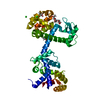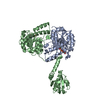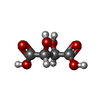+Search query
-Structure paper
| Title | Chimeric single α-helical domains as rigid fusion protein connections for protein nanotechnology and structural biology. |
|---|---|
| Journal, issue, pages | Structure, Vol. 30, Issue 1, Page 95-106.e7, Year 2022 |
| Publish date | Jan 6, 2022 |
 Authors Authors | Gabriella Collu / Tobias Bierig / Anna-Sophia Krebs / Sylvain Engilberge / Niveditha Varma / Ramon Guixà-González / Timothy Sharpe / Xavier Deupi / Vincent Olieric / Emiliya Poghosyan / Roger M Benoit /  |
| PubMed Abstract | Chimeric fusion proteins are essential tools for protein nanotechnology. Non-optimized protein-protein connections are usually flexible and therefore unsuitable as structural building blocks. Here we ...Chimeric fusion proteins are essential tools for protein nanotechnology. Non-optimized protein-protein connections are usually flexible and therefore unsuitable as structural building blocks. Here we show that the ER/K motif, a single α-helical domain (SAH), can be seamlessly fused to terminal helices of proteins, forming an extended, partially free-standing rigid helix. This enables the connection of two domains at a defined distance and orientation. We designed three constructs termed YFPnano, T4Lnano, and MoStoNano. Analysis of experimentally determined structures and molecular dynamics simulations reveals a certain degree of plasticity in the connections that allows the adaptation to crystal contact opportunities. Our data show that SAHs can be stably integrated into designed structural elements, enabling new possibilities for protein nanotechnology, for example, to improve the exposure of epitopes on nanoparticles (structural vaccinology), to engineer crystal contacts with minimal impact on construct flexibility (for the study of protein dynamics), and to design novel biomaterials. |
 External links External links |  Structure / Structure /  PubMed:34587504 PubMed:34587504 |
| Methods | EM (single particle) / X-ray diffraction |
| Resolution | 1.901 - 2.9 Å |
| Structure data |  EMDB-13292:  PDB-6hr1:  PDB-6xyr:  PDB-6yt3: |
| Chemicals |  ChemComp-TLA:  ChemComp-CA:  ChemComp-EDO:  ChemComp-GOL:  ChemComp-NA:  ChemComp-HOH:  ChemComp-CL:  ChemComp-ATP:  ChemComp-MG: |
| Source |
|
 Keywords Keywords | Fusion protein / fluorescent engineered / STRUCTURAL PROTEIN / crystal engineering / rigid helix / molecular biomimetics |
 Movie
Movie Controller
Controller Structure viewers
Structure viewers About Yorodumi Papers
About Yorodumi Papers



 Azotobacter vinelandii (bacteria)
Azotobacter vinelandii (bacteria)

 homo sapiens (human)
homo sapiens (human) enterobacteria phage t4 (virus)
enterobacteria phage t4 (virus)